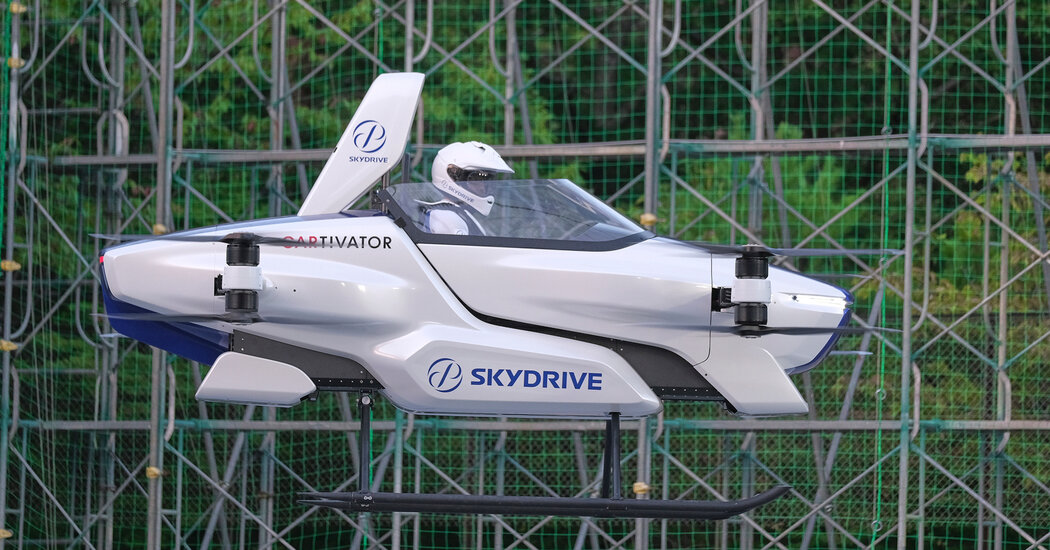In the 1880s, the first automobile was developed and about two decades later, the Wright brothers in North Carolina invented the first successful airplane. Today, the world is closer to combining those two concepts as a Japanese tech company said it completed a manned test flight of a “flying car.”
The company, SkyDrive, said in a news release on Friday that it had completed a flight test using “the world’s first manned testing machine,” its SD-03 model, an electrical vertical takeoff and landing (eVTOL) vehicle. The flight time was four minutes, the company said.
The aircraft has one seat and operates with eight motors and two propellers on each corner. It lifted about 3 meters (or about 10 feet) into the air and was operated by a pilot, the company said.
Tomohiro Fukuzawa, SkyDrive’s chief executive, said on Saturday that five years ago there were various prototypes of flying cars, usually with fixed wings. SkyDrive’s product, he said, was one of the most compact in size and was lighter compared with other designs.
SkyDrive was started in 2012 by members of a volunteer organization called Cartivator, and the company began developing a “flying car” in 2014, according to its website.
This year, SkyDrive received funding from the Development Bank of Japan and other investors, the company said.
There are several companies developing similar technology, including Boeing and Airbus, as well as automakers Toyota and Porsche. In January, Hyundai and Uber announced they were collaborating on an all-electric air taxi.
Analysts with Morgan Stanley have said they expect urban air taxis to be common by 2040, with the global market projected to be $1.4 trillion to $2.9 trillion by then.
Safety is one of two challenges preventing the technology from becoming widely used, said Derya Aksaray, an assistant professor of aerospace engineering and mechanics at the University of Minnesota. Safe autonomous technology for eVTOL aircrafts is still being developed, Professor Aksaray said.
“These vehicles need to look at their environment, assess the situation and act accordingly,” she said. “They cannot wait for a pilot or an operator to say, ‘Now do this, now do that.’ We cannot wait for that kind of micromanagement of the vehicle.”
The other challenge is design: The vehicles should be powerful enough to carry any necessary weight, yet quiet enough to fly at undetermined low altitudes, she said.
Ella Atkins, a professor of aerospace engineering at the University of Michigan, expressed mixed views on the practicality of eVTOL machines.
“They are going to be more energy efficient than helicopters that use a lot of fuel but they will be less energy efficient than cars because they have to lift themselves,” she said. “From a cost perspective, they won’t be practical to go to the grocery store.”
Professor Atkins said these machines may be better suited for satellite communities of cities or countries with difficult terrain.
“These vehicles can provide transportation,” Professor Atkins said, adding that “these communities might skip right over having roads” and use the aircraft as their main form of transportation.
Mr. Fukuzawa said SkyDrive plans to begin selling a two-seat version of its eVTOL by 2023 for about $300,000 to $500,000. He projected the price will decrease by 2030.
“With any new technology, it will be very expensive in the beginning,” Professor Aksaray said.
Professor Atkins echoed that observation and said it’s unlikely that private citizens with a modest income would be able to afford one in the next 20 years.
“We’re at the entrant phase,” she said. “We don’t have the mass production we would need to buy down the costs of all the development, research, deployment and manufacturing at a small scale.”
Professor Aksaray said humans are on the verge of a new mobility revolution, reminiscent of the ones created by the invention of the automobile and the plane.
“If this becomes successful,” she said, “I think that would definitely create a different means of transportation. We are going to benefit a lot by reducing congestion and overcoming the geographical constraints of ground mobility.”
[ad_2]
Source link



